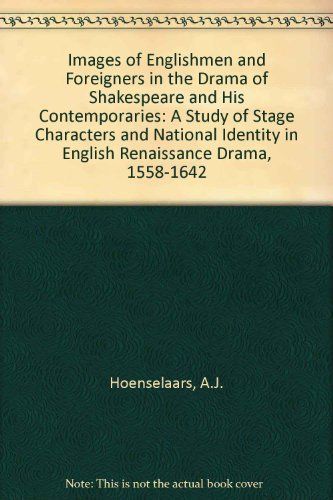
Images of Englishmen and Foreigners in the Drama of Shakespeare and His Contemporaries A Study of Stage Characters and National Identity in English Renaissance Drama, 1558-1642
The emergent national awareness in Europe during the early modern period revealed itself as patriotism and xenophobia during the age of Elizabeth. These sentiments were mainly induced by England's stance in the politico-religious debate that divided Europe, and by the arrival of refugees from abroad who placed a burden on the national economy. The popular feeling led to a multifaceted crystallization of matters native and foreign on the London stage. One manifestation of the new preoccupation was the presentation of stage characters with distinct nationalities. Drawing on stock traits, the dramatists initially created a stage world in which the Englishman was almost invariably superior to the foreigner, both in the native environment and in a continental setting. The glorification of the nation's self-image at the expense of others, however, was not to persist. English society largely absorbed the original shock induced by the influx of foreigners, and toward the end of the 1590s xenophobia lost its strident tone. Patriotism, too, was modified. The year 1588 became a historical date as James I's peace policy grew into the most popular news topic of his reign. These sociopolitical changes challenged the original images of Englishmen and foreigners in the drama. Under a climate with England ignominiously vacating the European political stage, it was difficult to uphold the once unquestioned self-image of the warlike nation. One group of dramatists, therefore, came to present the image as a forsaken ideal that could only be realized if the nation resumed its international duties. Other dramatists presented it as a past ideal and accepted it as an object for nostalgic self-gratification. The favorable self-image also became a target for the satirists. They attacked the old definition of the English and assigned to their own countrymen those properties which had previously been attributed to the foreigner. The caustic speculation on national character traits in Stuart drama was not only induced by the playwrights' discontent with the anachronistic and complimentary Elizabethan self-image. It also represented a budding skepticism with regard to the generalizing tendency involved in the definitions of national character. Inevitably, the image of the foreigner in the drama profited from the redefinition of the Englishman's auto-stereotyped image. As the satire which had previously been aimed at the foreigner came to be largely directed against the Englishman, a degree of rapprochement was established. There was a new exchange, as Richard Brome formulated it in the subtitle to his New Academy. Until the closing of the theaters in 1642, the satirical redefinition of the English national character persisted alongside the nostalgic confirmation of the favorable Elizabethan self-image. These divergent views expressed on the London stage bring into focus a national identity crisis. It parallels the growing contemporary conviction that the nation had traded in its decisive role on the European political scene for that of a passive onlooker.